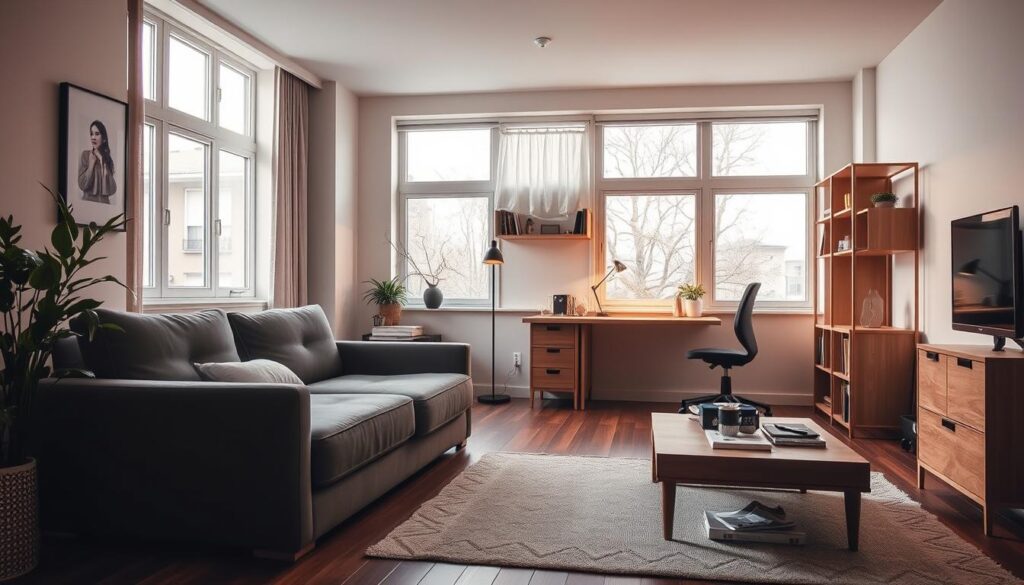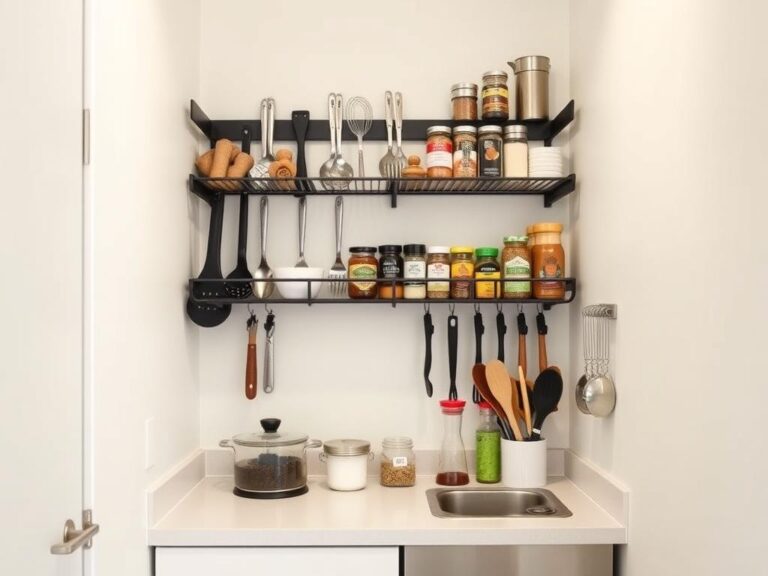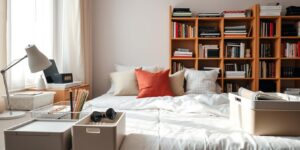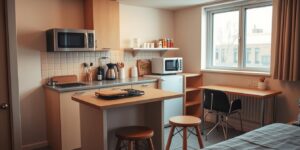The best multipurpose furniture for student apartments
Explore our list of the best multipurpose furniture for student apartments, designed to optimize space and functionality.
Living in compact housing requires smart solutions that balance practicality and comfort. Many young residents face tight quarters where every inch counts, demanding items that do more than one job. Clever designs can turn cramped areas into organized zones for studying, relaxing, and hosting friends.

Versatile pieces like sofa beds or foldable desks adapt to daily needs without dominating the room. These options help maintain a clutter-free environment while offering hidden storage or adjustable features. The right choices create a sense of openness, even in modest square footage.
Prioritizing flexible layouts ensures spaces evolve alongside changing routines. Items that seamlessly transition between functions reduce the need for multiple bulky pieces. This approach not only saves room but also supports a balanced lifestyle in shared accommodations.
Key Takeaways
- Dual-function items maximize limited room layouts
- Adaptable designs maintain organization in tight quarters
- Foldable or expandable options enhance daily flexibility
- Smart storage solutions reduce visual clutter
- Lightweight materials simplify rearrangement
Introduction: Transforming Student Apartments with Multi-Functional Furnishings
Urban students face a unique challenge: creating functional living areas in spaces smaller than most walk-in closets. With city rents soaring, every inch becomes precious real estate. This reality has sparked a design revolution focused on efficiency without compromise.
Understanding the Need for Space-Saving Solutions
Compact layouts require items that pull double duty. A desk becomes a dining table. A storage ottoman transforms into guest seating. These solutions tackle the core issue of too much stuff, not enough room.
Vertical designs help reclaim lost areas. Wall-mounted shelves and lofted beds free up floor space for movement. Foldable options disappear when not in use, maintaining visual calm in tight quarters.
What Else Would You Like to Know?
Choose below:
The Role of Design in Urban Living
Smart layouts prioritize adaptability. Modular pieces can shift configurations for study sessions or social gatherings. Lightweight materials make rearranging effortless as daily needs evolve.
Clever details matter most in studio settings. Built-in charging stations, hidden compartments, and convertible surfaces turn limitations into advantages. The right choices create rooms that work harder than their square footage suggests.
Understanding the Concept of Multipurpose Furniture
Modern living demands innovation, especially when square footage comes at a premium. Dual-purpose items have emerged as game-changers, merging functionality with smart design to address spatial constraints. These pieces eliminate the need for separate items while maintaining aesthetic appeal.
These designs go beyond basic fold-out options. Adjustable-height surfaces serve as workstations by day and dining spots by night. Seating with hidden compartments offers both comfort and organization.
Build quality matters for items that change roles daily. Manufacturers use reinforced joints and scratch-resistant finishes to handle constant adjustments. This ensures longevity despite frequent transformations.
Different layouts call for specific types of transformable solutions. Modular units work well in studio setups where zones serve multiple purposes. Rolling carts with dual surfaces adapt to evolving needs in shared environments.
Investing in well-crafted dual-role items often costs less long-term than buying separate pieces. Students save money while maintaining an organized, adaptable living area.
Enhancing Small Spaces with multipurpose furniture for student apartments
Smart spatial strategies redefine how we inhabit limited square footage. By blending form and function, compact environments gain new potential without sacrificing style. Thoughtful layouts create breathing room where none seems to exist.
Why Compact Layouts Demand Creative Solutions
Studio layouts thrive when items pull double duty. A wall-mounted desk folds into a mirror, while storage ottomans triple as seating and side tables. These tricks maintain clear pathways in tight quarters.
Zoning matters in single-room dwellings. A bookshelf divider separates sleep and study areas visually. Curtains hung from ceiling tracks create temporary privacy screens during video calls.
“Organized environments reduce cognitive overload by 38%,” notes Dr. Ellen Torres, environmental psychologist. “Students perform better when their surroundings support both focus and relaxation.”
| Feature | Traditional Approach | Smart Solution |
|---|---|---|
| Floor Space Usage | Bulky standalone pieces | Nesting tables + wall beds |
| Functionality | Single-purpose items | Convertible desk-beds |
| Cost Efficiency | Multiple purchases | All-in-one investments |
| Visual Impact | Cluttered surfaces | Hidden storage compartments |
Exam seasons test these designs most. Fold-away workstations preserve relaxation zones after study marathons. Adjustable lighting systems adapt to both task needs and wind-down hours.
Shared dwellings benefit from mobile solutions. Rolling kitchen islands become group project hubs, then cocktail stations for Friday gatherings. Every inch earns its keep through strategic flexibility.
Smart Storage Solutions to Maximize Floor Space
Optimizing square footage starts with intelligent organization systems. Vertical designs and hidden compartments keep essentials accessible without cluttering walkways. One customer praised heavy-duty shelving units: “The adjustable shelves handle textbooks and kitchen gear without bending. No wasted gaps between compartments.”

Modular Shelving and Cabinet Options
Adaptable shelving systems grow with changing needs. Units starting at $149.99 offer nine finishes and three heights to match room layouts. Full-height cabinets with sliding doors conceal bulkier items while maintaining clean sightlines.
Customizable Closets and Storage Units
Closet organizers transform cramped nooks into efficient zones. Adjustable rods, pull-out bins, and shoe racks maximize every inch. Dual-depth shelves store seasonal clothes behind daily wear, doubling functional capacity.
| Feature | Basic Storage | Smart Solution |
|---|---|---|
| Vertical Usage | Single-level stacking | Floor-to-ceiling units |
| Adjustability | Fixed shelf heights | Modular configurations |
| Cost Efficiency | Frequent replacements | 10-year frame warranty |
| Design Impact | Visual clutter | Hidden wire management |
Rolling drawer units tuck under beds or desks, freeing up floor areas. Multi-tier carts serve as portable pantries or craft stations. These choices prove that smart storage isn’t about having more space—it’s about using what you have better.
Convertible Seating Options: Sofas, Desks, and More
Today’s compact living spaces demand seating that works as hard as their occupants. Innovative designs now merge relaxation zones with productivity hubs, eliminating the need for separate areas. These pieces adapt to daily rhythm shifts, supporting both leisure and focus.
Designs That Double Up as Workspaces
Modern sofa models hide pull-out desk surfaces in armrests or back panels. One popular design features a 24-inch workspace that locks securely when closed. High-density foam cushions maintain comfort during marathon study sessions.
Modular sectionals offer another smart solution. Individual seats detach to create impromptu floor chairs or laptop stands. “The ability to reconfigure layouts in seconds helps students mentally shift between relaxation and work modes,” explains interior designer Mara Voss.
Built-in storage compartments address clutter challenges. Deep seat cushions lift to reveal space for textbooks or bedding. Some models include USB ports and cable organizers, keeping living room areas tidy during project work.
| Feature | Traditional Seating | Convertible Option |
|---|---|---|
| Surface Area | Fixed armrests | Slide-out desk (24″x18″) |
| Mobility | Stationary units | Swivel base with locking wheels |
| Durability | Basic frame | Steel reinforcement joints |
Dual-function seating proves particularly useful in studio layouts. A single piece can define zones while serving multiple purposes – lounge spot by evening, ergonomic desk chair by day. This flexibility maximizes every square foot without compromising style.
Innovative Dining and Coffee Table Designs
Gone are the days when tables served single purposes. Modern designs now feature patented adjustment systems that morph surfaces to meet changing needs. A coffee table can rise to desk height for study sessions, then expand into a full dining surface for group meals.
High-quality mechanisms enable smooth transitions between functions. Gas-spring lifts and sliding panels allow quick changes without tools. These systems handle daily adjustments while maintaining sleek profiles.
Space efficiency reaches new levels with expandable models. One popular design stretches from 24″ to 72″ wide, seating two to twelve people. “This table handles study sessions and dinner parties without missing a beat,” says NYU junior Liam Chen.
| Feature | Traditional Tables | Smart Designs |
|---|---|---|
| Height Adjustment | Fixed | 16″-30″ range |
| Surface Area | Static | Expandable by 200% |
| User Capacity | 4-6 people | 2-12 guests |
| Space Efficiency | Low | High |
| Cost Approach | Multiple purchases | Single investment |
Dual-texture finishes let users flip surfaces between casual and formal settings. Matte wood sides rotate to reveal glossy white tops – perfect for transitioning from coffee breaks to presentations.
These solutions prove particularly valuable in compact living situations. By replacing three separate pieces, they free up floor space while offering unmatched versatility. The initial investment pays off through years of adaptable use.
Murphy Beds and Wall Beds for Dual Functionality
Wall-mounted sleep solutions revolutionize how we use vertical space in compact homes. These innovative designs fold away completely, converting bedrooms into functional daytime zones. Unlike traditional layouts that anchor rooms to single purposes, these systems adapt to daily rhythms.
Space Transformation Through Smart Design
Modern wall beds blend seamlessly with cabinetry, hiding sleeping areas when not needed. Many models include built-in shelves or fold-down desks that remain accessible even when the bed is stored. This approach maintains living area functionality without compromising comfort.
Hidden Storage for Clutter-Free Zones
Clever compartments turn bed frames into organizational hubs. Deep drawers beneath mattress platforms store linens, while overhead cabinets hold clothing. One user reports: “My studio feels twice as big now that my bed holds winter coats and extra pillows.”
| Feature | Standard Bed | Wall Bed Solution |
|---|---|---|
| Floor Space | Permanent 30 sq.ft | 0 sq.ft when stored |
| Functionality | Sleep only | Workspace + storage |
| Installation | Fixed position | Wall-mounted system |
| Aesthetic Impact | Dominates room | Blends with decor |
Customization options let residents match cabinet finishes to existing decor. Some models feature magnetic boards or integrated lighting for added utility. These beds prove particularly valuable in studio settings where spatial flexibility determines quality of life.
Safety mechanisms ensure smooth operation, with hydraulic lifts supporting weights up to 300lbs. “The ease of conversion surprised me,” shares a Boston University senior. “I reclaim my entire room for yoga or study sessions every morning.”
Customizable Solutions: Shelving and Cabinets
Adaptable storage systems reshape how we organize compact living areas. Modular designs blend with existing layouts while offering personalized configurations for books, tech gear, and seasonal items. These solutions grow alongside changing needs, eliminating the hassle of frequent replacements.
Adjustable Designs for Varied Needs
Open shelving units with movable brackets accommodate oversized textbooks or decorative pieces. Cabinet systems featuring interchangeable inserts transform from shoe organizers to snack pantries in minutes. One user notes: “Swapping shelf heights during finals week kept my study materials within arm’s reach.”
| Feature | Basic Storage | Custom Solution |
|---|---|---|
| Height Adjustments | Fixed every 12″ | 1″ increments |
| Weight Capacity | 15 lbs/shelf | 50 lbs/shelf |
| Configuration Changes | Requires tools | Tool-free in 5 mins |
Vertical units maximize unused wall areas above desks or beds. Slim profiles prevent overcrowding in narrow walkways. Glass-front cabinets maintain visibility while reducing dust buildup on stored items.
Quality systems transition seamlessly between living situations. Durable steel frames withstand multiple moves, while interchangeable panels match new room aesthetics. This adaptability makes them practical investments beyond academic years.
Creative Uses of Multi-Functional Tables
Central hubs of activity in compact homes now wear multiple hats through smart engineering. These surfaces adapt to daily rhythms, morphing from workstations to social hubs without missing a beat.
Transformable Tables for Dining and Desk Use
Height-adjustable models shine in studio environments. A 24-inch coffee table rises to 30 inches for laptop work, then extends to dining height for shared meals. Hydraulic mechanisms enable smooth transitions in seconds.
One Columbia University junior reports: “My expandable surface handles breakfast, afternoon coding sessions, and game nights. It’s like having three tables in one footprint.”
| Feature | Standard Table | Smart Design |
|---|---|---|
| Daily Uses | 1-2 functions | 4+ activities |
| Space Required | Fixed area | Adjusts to room flow |
| Cost Efficiency | $200-$500 | $350-$700 |
Strategic placement defines zones without walls. Positioning near windows creates a bright study area that converts to dinner seating. Built-in power strips keep devices charged without cluttering surfaces.
Durable construction matters for daily transformations. Look for scratch-resistant tops and reinforced legs. These features ensure surfaces stay pristine despite constant use changes.
Incorporating Office Furniture into Student Living Areas
Blending workspaces with relaxation zones requires clever design choices that serve dual roles without compromising comfort. Modern solutions now integrate professional functionality into residential settings, creating areas that transition seamlessly between study sessions and downtime.
Dual-Purpose Desks with Storage
The Project 62 Loring Secretary Desk exemplifies smart design with built-in electrical outlets and USB ports. Its concealed compartments keep supplies organized while maintaining a clean aesthetic. When closed, it resembles a sleek cabinet rather than a workspace.
Key features include:
- Vertical file organizers for course materials
- Locking drawers for valuables
- Cable management systems behind flip-down surfaces
Efficient Layouts for Home Offices
Strategic placement creates distinct zones in shared environments. Positioning desks near natural light sources boosts productivity, while room dividers help mentally separate work from leisure activities.
| Traditional Setup | Smart Approach |
|---|---|
| Dedicated office corner | Convertible wall-mounted unit |
| Separate storage furniture | Built-in desk compartments |
| Permanent equipment display | Fold-away tech stations |
Lightweight mobile carts offer additional flexibility. They serve as printer stands during study hours and snack stations during breaks. This adaptability helps maintain balance in compact environments.
Optimizing Studio, Living Room, and Kitchen Layouts
Smart spatial planning turns cramped quarters into efficient living machines. Studio dwellers gain breathing room through intentional arrangements that serve multiple roles. The secret lies in treating every square foot as a flexible asset rather than fixed real estate.
Layout Tips for Maximizing Every Square Foot
Zoning strategies create invisible boundaries in open areas. A living room might use rugs to define entertainment zones while leaving pathways clear. Kitchens benefit from vertical storage towers that keep countertops free for meal prep.
Modular seating arrangements adapt to daily needs. Lightweight chairs stack neatly when not hosting guests. Wall-mounted drop-leaf tables provide instant dining surfaces without permanent space claims.
| Feature | Traditional Approach | Smart Solution |
|---|---|---|
| Zoning Method | Physical dividers | Visual cues + lighting |
| Storage Approach | Floor cabinets | Ceiling-high shelving |
| Flexibility | Fixed layouts | Mobile islands on casters |
Natural light enhances perceived space in studio environments. Sheer window treatments maintain brightness while offering privacy. Strategic mirror placements amplify sunlight penetration into kitchen corners.
Ventilation patterns influence furniture placement. Avoid blocking airflow paths with bulky items. Opt for open-base designs that let air circulate freely beneath beds and sofas.
Balancing Aesthetics and Functionality
Creating inviting environments in tight quarters demands equal attention to visual appeal and practical needs. Smart design eliminates the false choice between style and utility, proving compact spaces can excel at both. The secret lies in selecting pieces that enhance daily life while elevating room character.
Materials play dual roles—brushed metal accents add modern flair while resisting scratches. Neutral color palettes maintain calmness, letting functional items like storage ottomans pop as intentional decor. Textured wall panels introduce depth without consuming floor space.
Layout strategies maintain visual harmony. Floating shelves display plants alongside textbooks, merging organization with personality. Mirrors near light sources amplify brightness, making narrow areas feel airier. These touches preserve efficient flow while expressing individual style.
True success emerges when spaces feel both intentional and adaptable. By blending smart engineering with artistic vision, limited square footage becomes a canvas for innovation. The result? Environments that support productivity while sparking joy—no compromises required.
FAQ
How can I maximize floor space in a studio apartment?
What’s the best way to combine sleeping and living areas?
Are there dining tables that work as desks?
How do I add storage without sacrificing style?
Can small spaces handle overnight guests?
What’s a budget-friendly option for dual-purpose furniture?
How do I create a home office in a studio?
Tiny Kitchen, Big Ideas: Organizing Your Small Student Kitchen
» See exclusive tips for your home








